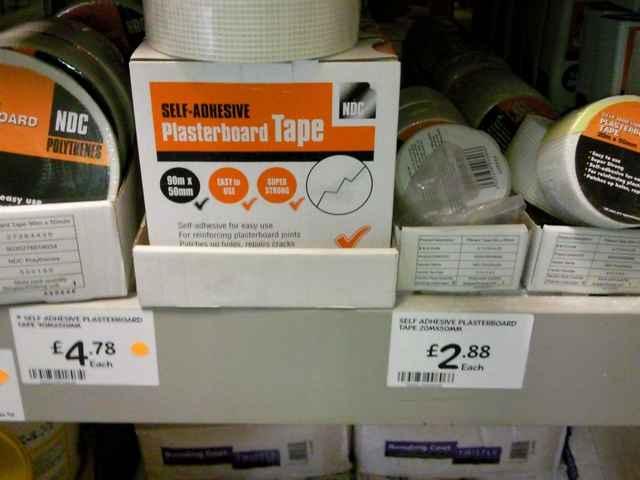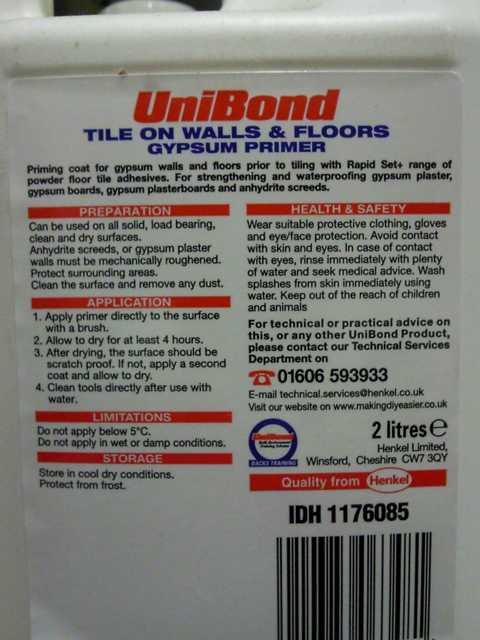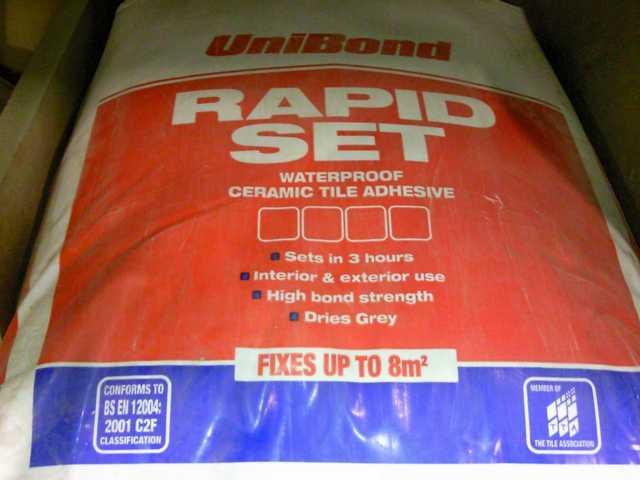Just after some overall tips please guys I've read so much, plenty of it conflicting with each other, some saying that things should never been done, some saying that things are fine, and some saynig that some things are overkill for domestic installations - lol
So, I've taken out the old bathroom suite; bath with overhead powershower, sink & toilet, and removed the full wall tiling.
This was onto plasterboard, which I have repaired any damaged sections of and cleaned all the old adheisve / grout etc from.
I cannot realistically change the plasterboard as it forms one skin of a 'honeycomb filled prefab wall' from the looks of thing, hence the repairing.
I can also not 'overboard' it with anything, as doing so will decrease the bathroom size such that the bath won't fit - lol The walls of the bathroom are 'just' far enough apart to take the bath.
The tiles that I will be fitting (Homebase Verona )are 8mm thick, 25cm x 33cm tiles.
The plasterboard is of the bevelled edge type, which looks like it had a jointing tape fitted over, and then plaster applied, (not over the full wall, just the joints).
Do I need to replace this jointing tape and apply a plastercoat, or will tile adhesive just fill this slight 'dip' ?
Everything I had read also said about priming 'stripped back' plasterboard with a 5:1 water va mix, so I have applied that to all of the plasterboard.
va mix, so I have applied that to all of the plasterboard.
However I have now read (in some places) that this shouldn't be done, and yet I've read in other places that it MUST be done... which is correct? If I shouldn't have done it will a damp sponge take off the pva mix (although it seems to have soaked into the plasterboard).
I've also read about 'tanking' the plasterboard. Some say in a shower area this must be done, others say that in a domestic environment it is unneccasary overkill. Obviously when I have stripped out the old tiling there is / was no tanking behind it.
Is tanking needed? How / what do I need to do it if so? Roughly what cost?
I will be refitting a toilet sink and bath as before, and also a pumped mixer shower, not sure if this makes the slightest difference, but wanted the information to be here
Lastly, as we have cavity walls the bathroom window is 'set in' and there is a ledge all round the window. Previously this was tiled, but when trying to remove the tiles I pulled off the old plasterboard strip that was 'dot-n-dab'ed to the top of the alcove. I am going to replace it with new plasterboard, but can I just afix this to the 'dabs' that are still attached to the top of the alcove, or do I need to do something different to ensure it doesn't fall down with the weight of the tiles on it? (It did have tiles on before)
Sorry for the long post, but I thought I was all ready to start refittting the bathroom and tiling, and now I'm right back into a dilema about whether I've done what needs doing preperation wise
So, I've taken out the old bathroom suite; bath with overhead powershower, sink & toilet, and removed the full wall tiling.
This was onto plasterboard, which I have repaired any damaged sections of and cleaned all the old adheisve / grout etc from.
I cannot realistically change the plasterboard as it forms one skin of a 'honeycomb filled prefab wall' from the looks of thing, hence the repairing.
I can also not 'overboard' it with anything, as doing so will decrease the bathroom size such that the bath won't fit - lol The walls of the bathroom are 'just' far enough apart to take the bath.
The tiles that I will be fitting (Homebase Verona )are 8mm thick, 25cm x 33cm tiles.
The plasterboard is of the bevelled edge type, which looks like it had a jointing tape fitted over, and then plaster applied, (not over the full wall, just the joints).
Do I need to replace this jointing tape and apply a plastercoat, or will tile adhesive just fill this slight 'dip' ?
Everything I had read also said about priming 'stripped back' plasterboard with a 5:1 water
However I have now read (in some places) that this shouldn't be done, and yet I've read in other places that it MUST be done... which is correct? If I shouldn't have done it will a damp sponge take off the pva mix (although it seems to have soaked into the plasterboard).
I've also read about 'tanking' the plasterboard. Some say in a shower area this must be done, others say that in a domestic environment it is unneccasary overkill. Obviously when I have stripped out the old tiling there is / was no tanking behind it.
Is tanking needed? How / what do I need to do it if so? Roughly what cost?
I will be refitting a toilet sink and bath as before, and also a pumped mixer shower, not sure if this makes the slightest difference, but wanted the information to be here
Lastly, as we have cavity walls the bathroom window is 'set in' and there is a ledge all round the window. Previously this was tiled, but when trying to remove the tiles I pulled off the old plasterboard strip that was 'dot-n-dab'ed to the top of the alcove. I am going to replace it with new plasterboard, but can I just afix this to the 'dabs' that are still attached to the top of the alcove, or do I need to do something different to ensure it doesn't fall down with the weight of the tiles on it? (It did have tiles on before)
Sorry for the long post, but I thought I was all ready to start refittting the bathroom and tiling, and now I'm right back into a dilema about whether I've done what needs doing preperation wise








